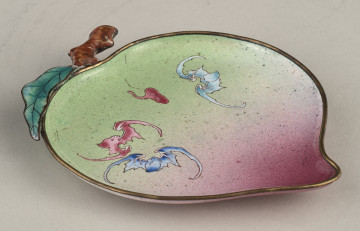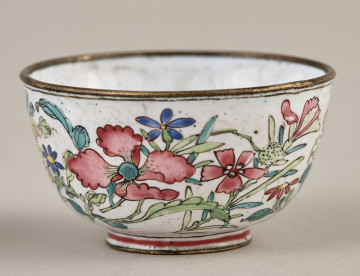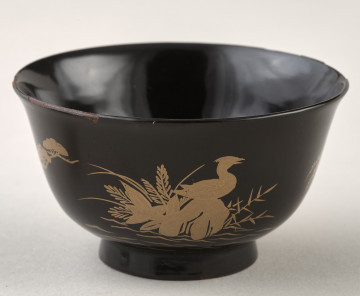
Saucer
18th-19th century
Castle Museum in Łańcut
Part of the collection: Orient
Wooden saucer in the shape of a shallow bowl with arched sides and a straight bottom. The saucer is made of primed wood, entirely covered with black kuro-urushi lac, polished, sprayed with gold in the decorative fields.The walls of the saucer are decorated with a gilded garland composed of trifoliate leaves, grapevine and an eight-petalled floral rosette. It forms a set with the teapot, inv. no. S.2369MŁ. Japan, Edo period, Tsugaru workshop, Aomori province, dated 17th/18th century. Lac is the resin of the Japanese sumac tree, which grows south of the Yangtze River, and is used in Japanese and Chinese decorative arts. It is often tinted. Japanese sumac resin is obtained by incising the bark, and then a thick sap flows from the tree in the form of gray emulsion. This substance darkens upon contact with air and hardens after evaporation of water. The resin is then purified and colored with metal oxides. The skeleton of the object was mainly made of sanded wood, sometimes covered with paper or canvas to even out the surface. Leather, metal, papier-mâché and a bamboo braid were also lacquered. Lac was applied many times before layering. After hardening, the surface was thoroughly polished. The number of layers applied depended on the decoration technique. In the case of smooth backgrounds a few layers were enough, in the case of carving even a few hundred. Lac provided the background for decoration. Lacquerwork techniques can generally be divided into incrustation, carving and decoration. The first two techniques originate from Chinese art, while carving is a Japanese contribution. Black and red lac was used to cover trays, combs, jewelry, clay vessels and even armors and coffins. The oldest lacquerware dates back to the 4th millennium BC. Over the centuries the art of lacquerware decoration almost disappeared, but was revived again in the 18th / 17th century AD. Lac was used to make or decorate furniture, dishes and paintbrushes. The process of decorating with this type of lac consisted of repeatedly covering the surface with resin and carving an ornament in each layer, which added the spatiality to the decoration. Lacquerware was first brought to Europe in the 16th century by the Jesuits. Lac became popular in the 17th and 18th centuries.
Author / creator
Dimensions
height: 2.6 cm
Object type
Orient
Technique
painting
Material
wood, lacquer
Creation time / dating
Creation / finding place
Owner
Castle Museum in Łańcut
Identification number
Location / status

18th-19th century
Castle Museum in Łańcut

2nd half of the 19th century
Castle Museum in Łańcut

18th-19th century
Castle Museum in Łańcut
DISCOVER this TOPIC
Museum of King Jan III's Palace at Wilanów
DISCOVER this PATH
Educational path